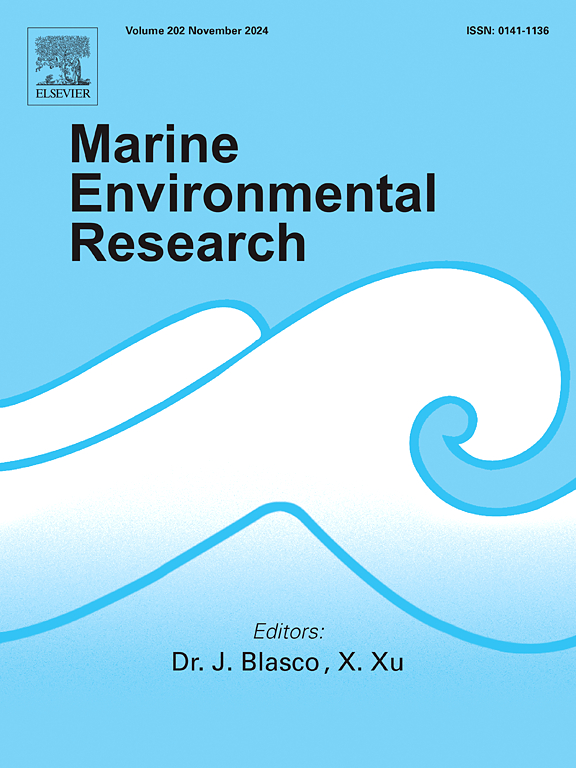Long-term variability in sea surface temperature and chlorophyll-a concentration in the Pacific region off Baja California
IF 3
3区 环境科学与生态学
Q2 ENVIRONMENTAL SCIENCES
引用次数: 0
Abstract
The Pacific region off Baja California (PBC) is part of the California Current System (CCS), its high energy flux and transition zone between mid-latitude and tropical ocean conditions make it one of the most productive regions in the world. Given the variability of sea surface temperature (SST) and chlorophyll-a (Chl-a) in this area, it is necessary to establish regions for their independent study and the relationships between them. We used satellite imagery and cluster analysis to group stations with greatest homogeneity in these variables and regionalize the PBC. We evaluated the seasonal and interannual variability of SST and Chl-a from 2000 to 2022 and analyzed the associations of interannual variability with El Niño Southern Oscillation (ENSO) and the Pacific Decadal Oscillation (PDO). Results revealed seven bioregions characterized by strong latitudinal gradients in SST and Chl-a, with northern bioregions showing higher productivity than the southern ones. All bioregions showed strong seasonal and interannual variation in SST and Chl-a. Interannual (3–8 years) and decadal (10–12 years) cycles associated with ENSO and PDO were observed. A period (2000–2012) of cold-eutrophic conditions was observed, followed by a second period (2013–2022) of warm-oligotrophic waters. In this second period, “the Blob”, a very strong El Niño and a positive PDO phase had combined effects on the study area, significantly increasing SST and decreasing Chl-a, with no subsequent recovery to pre-2013 values after these three major events ceased. Additionally, all bioregions moved northwards, the southern ones covering larger areas, suggesting water tropicalization linked to global warming.

下加利福尼亚附近的太平洋地区(PBC)是加利福尼亚洋流系统(CCS)的一部分,其高能量通量和中纬度与热带海洋条件之间的过渡区使其成为世界上最富饶的地区之一。鉴于该地区海表温度(SST)和叶绿素 a(Chl-a)的多变性,有必要建立区域对它们进行独立研究,并研究它们之间的关系。我们利用卫星图像和聚类分析,将这些变量同质性最强的站点归类,并对 PBC 进行区域划分。我们评估了 2000 年至 2022 年期间 SST 和 Chl-a 的季节和年际变化,并分析了年际变化与厄尔尼诺南方涛动(ENSO)和太平洋十年涛动(PDO)的关联。结果显示,7 个生物区的 SST 和 Chl-a 具有强烈的纬度梯度特征,北部生物区的生产力高于南部生物区。所有生物区的 SST 和 Chl-a 都表现出强烈的季节和年际变化。观测到了与厄尔尼诺/南方涛动和 PDO 相关的年际(3-8 年)和十年(10-12 年)周期。观察到一段时期(2000-2012 年)的冷富营养化条件,随后是第二段时期(2013-2022 年)的暖寡营养水体。在第二个时期,"Blob"、极强的厄尔尼诺现象和正的 PDO 阶段对研究区域产生了综合影响,使海温显著升高,Chl-a 下降,在这三个主要事件停止后,Chl-a 没有恢复到 2013 年之前的值。此外,所有生物区都向北移动,南部生物区的面积更大,这表明水域热带化与全球变暖有关。
本文章由计算机程序翻译,如有差异,请以英文原文为准。
求助全文
约1分钟内获得全文
求助全文
来源期刊

Marine environmental research
环境科学-毒理学
CiteScore
5.90
自引率
3.00%
发文量
217
审稿时长
46 days
期刊介绍:
Marine Environmental Research publishes original research papers on chemical, physical, and biological interactions in the oceans and coastal waters. The journal serves as a forum for new information on biology, chemistry, and toxicology and syntheses that advance understanding of marine environmental processes.
Submission of multidisciplinary studies is encouraged. Studies that utilize experimental approaches to clarify the roles of anthropogenic and natural causes of changes in marine ecosystems are especially welcome, as are those studies that represent new developments of a theoretical or conceptual aspect of marine science. All papers published in this journal are reviewed by qualified peers prior to acceptance and publication. Examples of topics considered to be appropriate for the journal include, but are not limited to, the following:
– The extent, persistence, and consequences of change and the recovery from such change in natural marine systems
– The biochemical, physiological, and ecological consequences of contaminants to marine organisms and ecosystems
– The biogeochemistry of naturally occurring and anthropogenic substances
– Models that describe and predict the above processes
– Monitoring studies, to the extent that their results provide new information on functional processes
– Methodological papers describing improved quantitative techniques for the marine sciences.
 求助内容:
求助内容: 应助结果提醒方式:
应助结果提醒方式:


